Relationship between El Niño-Southern Oscillation and Atmospheric Aerosols in the Legal Amazon
Abstract
1. Introduction
2. Materials and Methods
2.1. ENSO Indicators Data
2.2. Atmospheric Aerosol Data
2.2.1. AERONET
2.2.2. MERRA-2
2.3. Specific Humidity Anomaly and Vertical Velocity Anomaly
2.4. Statistical Methodology
3. Results
3.1. Time Series Analysis
3.2. Windowed Cross-Correlation
3.3. Spatiotemporal Assessment
4. Discussion
4.1. The Walker Circulation
4.2. Specific Humidity Assessment
4.3. Aerosol Interaction
5. Conclusions
Supplementary Materials
Author Contributions
Funding
Data Availability Statement
Acknowledgments
Conflicts of Interest
References
- Schöngart, J.; Junk, W.J.; Piedade, M.T.F.; Ayres, J.M.; Hüttermann, A.; Worbes, M. Teleconnection between Tree Growth in the Amazonian Floodplains and the El Niño-Southern Oscillation Effect: Dendroclimatic Record of Amazon Floodplains. Glob. Chang. Biol. 2004, 10, 683–692. [Google Scholar] [CrossRef]
- Aragão, L.E.O.C.; Poulter, B.; Barlow, J.B.; Anderson, L.O.; Malhi, Y.; Saatchi, S.; Phillips, O.L.; Gloor, E. Environmental Change and the Carbon Balance of Amazonian Forests: Environmental Change in Amazonia. Biol. Rev. 2014, 89, 913–931. [Google Scholar] [CrossRef] [PubMed]
- Li, F.; Lin, W.; Jiang, B.; Li, J. Investigation of Aerosol Direct Effect over China under El Niño and Its Spatial Distribution Using WRF-Chem. Atmosphere 2020, 12, 58. [Google Scholar] [CrossRef]
- Zhou, Y.; Yan, H.; Luo, J.-J. Impacts of Amazon Fire Aerosols on the Subseasonal Circulations of the Mid-High Latitudes. Front. Earth Sci. 2021, 8, 609554. [Google Scholar] [CrossRef]
- Huijnen, V.; Wooster, M.J.; Kaiser, J.W.; Gaveau, D.L.A.; Flemming, J.; Parrington, M.; Inness, A.; Murdiyarso, D.; Main, B.; Van Weele, M. Fire Carbon Emissions over Maritime Southeast Asia in 2015 Largest since 1997. Sci. Rep. 2016, 6, 26886. [Google Scholar] [CrossRef]
- Artaxo, P.; Hansson, H.-C.; Andreae, M.O.; Bäck, J.; Alves, E.G.; Barbosa, H.M.J.; Bender, F.; Bourtsoukidis, E.; Carbone, S.; Chi, J.; et al. Tropical and Boreal Forest—Atmosphere Interactions: A Review. Tellus B Chem. Phys. Meteorol. 2022, 74, 24–163. [Google Scholar] [CrossRef]
- Alves, N.O.; Brito, J.; Caumo, S.; Arana, A.; De Souza Hacon, S.; Artaxo, P.; Hillamo, R.; Teinilä, K.; Batistuzzo De Medeiros, S.R.; De Castro Vasconcellos, P. Biomass Burning in the Amazon Region: Aerosol Source Apportionment and Associated Health Risk Assessment. Atmos. Environ. 2015, 120, 277–285. [Google Scholar] [CrossRef]
- Holanda, B.A.; Pöhlker, M.L.; Walter, D.; Saturno, J.; Sörgel, M.; Ditas, J.; Ditas, F.; Schulz, C.; Franco, M.A.; Wang, Q.; et al. Influx of African Biomass Burning Aerosol during the Amazonian Dry Season through Layered Transatlantic Transport of Black Carbon-Rich Smoke. Atmos. Chem. Phys. 2020, 20, 4757–4785. [Google Scholar] [CrossRef]
- Holanda, B.A.; Franco, M.A.; Walter, D.; Artaxo, P.; Carbone, S.; Cheng, Y.; Chowdhury, S.; Ditas, F.; Gysel-Beer, M.; Klimach, T.; et al. African Biomass Burning Affects Aerosol Cycling over the Amazon. Commun. Earth Environ. 2023, 4, 154. [Google Scholar] [CrossRef]
- Bond, T.C.; Bergstrom, R.W. Light Absorption by Carbonaceous Particles: An Investigative Review. Aerosol Sci. Technol. 2006, 40, 27–67. [Google Scholar] [CrossRef]
- Bond, T.C.; Doherty, S.J.; Fahey, D.W.; Forster, P.M.; Berntsen, T.; DeAngelo, B.J.; Flanner, M.G.; Ghan, S.; Kärcher, B.; Koch, D.; et al. Bounding the Role of Black Carbon in the Climate System: A Scientific Assessment: Black Carbon in the Climate System. J. Geophys. Res. Atmos. 2013, 118, 5380–5552. [Google Scholar] [CrossRef]
- Forbes, M.S.; Raison, R.J.; Skjemstad, J.O. Formation, Transformation and Transport of Black Carbon (Charcoal) in Terrestrial and Aquatic Ecosystems. Sci. Total Environ. 2006, 370, 190–206. [Google Scholar] [CrossRef]
- Barkley, A.E.; Prospero, J.M.; Mahowald, N.; Hamilton, D.S.; Popendorf, K.J.; Oehlert, A.M.; Pourmand, A.; Gatineau, A.; Panechou-Pulcherie, K.; Blackwelder, P.; et al. African Biomass Burning Is a Substantial Source of Phosphorus Deposition to the Amazon, Tropical Atlantic Ocean, and Southern Ocean. Proc. Natl. Acad. Sci. USA 2019, 116, 16216–16221. [Google Scholar] [CrossRef]
- Lou, S.; Yang, Y.; Wang, H.; Lu, J.; Smith, S.J.; Liu, F.; Rasch, P.J. Black Carbon Increases Frequency of Extreme ENSO Events. J. Clim. 2019, 32, 8323–8333. [Google Scholar] [CrossRef]
- Kim, M.-K.; Lau, W.K.M.; Kim, K.-M.; Sang, J.; Kim, Y.-H.; Lee, W.-S. Amplification of ENSO Effects on Indian Summer Monsoon by Absorbing Aerosols. Clim. Dyn. 2016, 46, 2657–2671. [Google Scholar] [CrossRef]
- Feng, J.; Zhu, J.; Li, J.; Liao, H. Aerosol Concentrations Variability over China: Two Distinct Leading Modes. Atmos. Chem. Phys. 2020, 20, 9883–9893. [Google Scholar] [CrossRef]
- Wang, J.; Liu, Y.; Ding, Y. On the Connection between Interannual Variations of Winter Haze Frequency over Beijing and Different ENSO Flavors. Sci. Total Environ. 2020, 740, 140109. [Google Scholar] [CrossRef]
- Oliveira, F.P.; Oyama, M.D. Squall-line Initiation over the Northern Coast of Brazil in March: Observational Features. Meteorol. Appl. 2020, 27, e1799. [Google Scholar] [CrossRef]
- Rizzo, L.V.; Artaxo, P.; Müller, T.; Wiedensohler, A.; Paixão, M.; Cirino, G.G.; Arana, A.; Swietlicki, E.; Roldin, P.; Fors, E.O.; et al. Long Term Measurements of Aerosol Optical Properties at a Primary Forest Site in Amazonia. Atmos. Chem. Phys. 2013, 13, 2391–2413. [Google Scholar] [CrossRef]
- Pöhlker, M.L.; Pöhlker, C.; Ditas, F.; Klimach, T.; Angelis, I.H.; Araújo, A.; Brito, J.; Carbone, S.; Cheng, Y.; Chi, X.; et al. Long-Term Observations of Cloud Condensation Nuclei in the Amazon Rain Forest—Part 1: Aerosol Size Distribution, Hygroscopicity, and New Model Parametrizations for CCN Prediction. Atmos. Chem. Phys. 2016, 16, 15709–15740. [Google Scholar] [CrossRef]
- Saturno, J.; Holanda, B.A.; Pöhlker, C.; Ditas, F.; Wang, Q.; Moran-Zuloaga, D.; Brito, J.; Carbone, S.; Cheng, Y.; Chi, X.; et al. Black and Brown Carbon over Central Amazonia: Long-Term Aerosol Measurements at the ATTO Site. Atmos. Chem. Phys. 2018, 18, 12817–12843. [Google Scholar] [CrossRef]
- Cai, W.; McPhaden, M.J.; Grimm, A.M.; Rodrigues, R.R.; Taschetto, A.S.; Garreaud, R.D.; Dewitte, B.; Poveda, G.; Ham, Y.G.; Santoso, A.; et al. Climate Impacts of the El Niño–Southern Oscillation on South America. Nat. Rev. Earth Environ. 2020, 1, 215–231. [Google Scholar] [CrossRef]
- Reboita, M.S.; Oliveira, K.R.; Corrêa, P.Y.C.; Rodrigues, R. Influence of the Different Types of El Niño in the Precipitation over South America. Rev. Bras. Geogr. Física 2021, 14, 729–742. [Google Scholar] [CrossRef]
- Trenberth, K.E. El Niño Southern Oscillation (ENSO). Encycl. Ocean. Sci. 2019, 3, 420–432. [Google Scholar] [CrossRef]
- Holben, B.N.; Eck, T.F.; Slutsker, I.; Tanré, D.; Buis, J.P.; Setzer, A.; Vermote, E.; Reagan, J.A.; Kaufman, Y.J.; Nakajima, T.; et al. AERONET—A Federated Instrument Network and Data Archive for Aerosol Characterization. Remote Sens. Environ. 1998, 66, 1–16. [Google Scholar] [CrossRef]
- Dayou, J.; Chang, J.H.W.; Sentian, J. Ground-Based Aerosol Optical Depth Measurement Using Sunphotometers; In SpringerBriefs in Applied Sciences and Technology, 1st ed.; Springer: Kota Kinabalu, Malaysia, 2014; Volume 1, pp. 1–67. [Google Scholar] [CrossRef]
- Li, J.; Ge, X.; He, Q.; Abbas, A. Aerosol Optical Depth (AOD): Spatial and Temporal Variations and Association with Meteorological Covariates in Taklimakan Desert, China. PeerJ 2021, 9, e10542. [Google Scholar] [CrossRef] [PubMed]
- Morais, F.G.; Franco, M.A.; Palácios, R.; Machado, L.A.T.; Rizzo, L.V.; Barbosa, H.M.J.; Jorge, F.; Schafer, J.S.; Holben, B.N.; Landulfo, E.; et al. Relationship between Land Use and Spatial Variability of Atmospheric Brown Carbon and Black Carbon Aerosols in Amazonia. Atmosphere 2022, 13, 1328. [Google Scholar] [CrossRef]
- Dehkhoda, N.; Sim, J.; Joo, S.; Shin, S.; Noh, Y. Retrieval of Black Carbon Absorption Aerosol Optical Depth from AERONET Observations over the World during 2000–2018. Remote Sens. 2022, 14, 1510. [Google Scholar] [CrossRef]
- Rushingabigwi, G.; Zhang, J.; Bachagha, T.; Kalisa, W.; Henchiri, M.; Shahzad, A.; Nsengiyumva, P.; Bugingo, C.N. The Influence of Dust and Black Carbon on Clouds, in Africa. J. Comput. Commun. 2018, 6, 342–352. [Google Scholar] [CrossRef]
- Buchard, V.; Randles, C.A.; Da Silva, A.M.; Darmenov, A.; Colarco, P.R.; Govindaraju, R.; Ferrare, R.; Hair, J.; Beyersdorf, A.J.; Ziemba, L.D.; et al. The MERRA-2 Aerosol Reanalysis, 1980 Onward. Part II: Evaluation and Case Studies. J. Clim. 2017, 30, 6851–6872. [Google Scholar] [CrossRef]
- Randles, C.A.; Silva, A.M.; Buchard, V.; Colarco, P.R.; Darmenov, A.; Govindaraju, R.; Smirnov, A.; Holben, B.; Ferrare, R.; Hair, J.; et al. The MERRA-2 Aerosol Reanalysis, 1980 Onward. Part I: System Description and Data Assimilation Evaluation. J. Clim. 2017, 30, 6823–6850. [Google Scholar] [CrossRef] [PubMed]
- Gelaro, R.; McCarty, W.; Suárez, M.J.; Todling, R.; Molod, A.; Takacs, L.; Randles, C.A.; Darmenov, A.; Bosilovich, M.G.; Reichle, R.; et al. The Modern-Era Retrospective Analysis for Research and Applications, Version 2 (MERRA-2). J. Clim. 2017, 30, 5419–5454. [Google Scholar] [CrossRef] [PubMed]
- Uma, K.N.; Das, S.S.; Ratnam, M.V.; Suneeth, K.V. Assessment of Vertical Air Motion among Reanalyses and Qualitative Comparison with Very-High-Frequency Radar Measurements over Two Tropical Stations. Atmos. Chem. Phys. 2021, 21, 2083–2103. [Google Scholar] [CrossRef]
- Boker, S.M.; Rotondo, J.L.; Xu, M.; King, K. Windowed Cross-Correlation and Peak Picking for the Analysis of Variability in the Association between Behavioral Time Series. Psychol. Methods 2002, 7, 338–355. [Google Scholar] [CrossRef] [PubMed]
- Zhang, W.; Li, Y.; Wu, X.; Chen, Y.; Chen, A.; Schwalm, C.R.; Kimball, J.S. Divergent Response of Vegetation Growth to Soil Water Availability in Dry and Wet Periods Over Central Asia. J. Geophys. Res. Biogeosci. 2021, 126, e2020JG005912. [Google Scholar] [CrossRef]
- Trenberth, K.E. The Definition of El Niño. Bull. Am. Meteorol. Soc. 1997, 78, 2771–2777. [Google Scholar] [CrossRef]
- Palácios, R.; Nassarden, D.C.S.; Franco, M.A.; Morais, F.G.; Machado, L.A.T.; Rizzo, L.V.; Cirino, G.; Pereira, A.G.C.; Ribeiro, P.D.S.; Barros, L.R.C.; et al. Evaluation of MODIS Dark Target AOD Product with 3 and 10 Km Resolution in Amazonia. Atmosphere 2022, 13, 1742. [Google Scholar] [CrossRef]
- Palácios, R.D.S.; Morais, F.G.; Landulfo, E.; Franco, M.A.D.M.; Kuhnen, I.A.; Marques, J.B.; Nogueira, J.D.S.; Júnior, L.C.G.D.V.; Rodrigues, T.R.; Romera, K.S.; et al. Long Term Analysis of Optical and Radiative Properties of Aerosols in the Amazon Basin. Aerosol Air Qual. Res. 2020, 20, 139–154. [Google Scholar] [CrossRef]
- Artaxo, P.; Gatti, L.V.; Leal, A.M.C.; Longo, K.M.; Freitas, S.R.D.; Lara, L.L.; Pauliquevis, T.M.; Procópio, A.S.; Rizzo, L.V. Atmospheric Chemistry in Amazonia: The forest and the biomass burning emissions controlling the composition of the Amazonian atmosphere. Acta Amaz. 2005, 35, 185–196. [Google Scholar] [CrossRef]
- Nascimento, G.C.; Senna, M.C.A. The Influence of El Niño and La Niña Events in the Evaluation of the Fire Risk in Pará. Anuário Inst. Geociências 2020, 43, 189–201. [Google Scholar] [CrossRef]
- Barbosa, M.L.F.; Delgado, R.C.; Forsad De Andrade, C.; Teodoro, P.E.; Silva Junior, C.A.; Wanderley, H.S.; Capristo-Silva, G.F. Recent Trends in the Fire Dynamics in Brazilian Legal Amazon: Interaction between the ENSO Phenomenon, Climate and Land Use. Environ. Dev. 2021, 39, 100648. [Google Scholar] [CrossRef]
- Silva Júnior, L.A.S.; Delgado, R.C.; Pereira, M.G.; Teodoro, P.E.; Da Silva Junior, C.A. Fire Dynamics in Extreme Climatic Events in Western Amazon. Environ. Dev. 2019, 32, 100450. [Google Scholar] [CrossRef]
- Kumar, A.; Hoerling, M.P. The Nature and Causes for the Delayed Atmospheric Response to El Ninõ. J. Clim. 2003, 16, 1391–1403. [Google Scholar] [CrossRef]
- Alexander, M.A.; Bladé, I.; Newman, M.; Lanzante, J.R.; Lau, N.-C.; Scott, J.D. The Atmospheric Bridge: The Influence of ENSO Teleconnections on Air–Sea Interaction over the Global Oceans. J. Clim. 2002, 15, 2205–2231. [Google Scholar] [CrossRef]
- Zang, L.; Wang, Z.; Zhu, B.; Zhang, Y. Roles of Relative Humidity in Aerosol Pollution Aggravation over Central China during Wintertime. Int. J. Environ. Res. Public Health 2019, 16, 4422. [Google Scholar] [CrossRef] [PubMed]
- Gushchina, D.; Zheleznova, I.; Osipov, A.; Olchev, A. Effect of Various Types of ENSO Events on Moisture Conditions in the Humid and Subhumid Tropics. Atmosphere 2020, 11, 1354. [Google Scholar] [CrossRef]
- Foley, J.A.; Botta, A.; Coe, M.T.; Costa, M.H. El Niño-Southern Oscillation and the Climate, Ecosystems and Rivers of Amazonia: Impact of Enso on Amazonian Ecosystems and Rivers. Glob. Biogeochem. Cycles 2002, 16, 79-1–79-20. [Google Scholar] [CrossRef]
- Withey, K.; Berenguer, E.; Palmeira, A.F.; Espírito-Santo, F.D.B.; Lennox, G.D.; Silva, C.V.J.; Aragão, L.E.O.C.; Ferreira, J.; França, F.; Malhi, Y.; et al. Quantifying Immediate Carbon Emissions from El Niño-Mediated Wildfires in Humid Tropical Forests. Philos. Trans. R. Soc. B Biol. Sci. 2018, 373, 20170312. [Google Scholar] [CrossRef]
- Sousa, A.M.L.; Rocha, E.J.P.D.; Vitorino, M.I.; Souza, P.J.O.P.; Botelho, M.N. Spatio-Temporal Variability of Precipitation in the Amazon during Enso Events. Rev. Bras. Geogr. Física 2015, 8, 13–24. [Google Scholar] [CrossRef]
- Souza, A.D.; Cavazzana, G.H.; Santos, D.A.D.S.; Abreu, M.C.; Fernandes, W.A.; Aristone, F. Relationship Between Aerosol Optical Depth and Precipitation Considering the Relative Humidity as an Influence Factor. GEOgraphia 2021, 23, a27224. [Google Scholar] [CrossRef]
- Schafer, J.S.; Holben, B.N.; Eck, T.F.; Yamasoe, M.A.; Artaxo, P. Atmospheric Effects on Insolation in the Brazilian Amazon: Observed Modification of Solar Radiation by Clouds and Smoke and Derived Single Scattering Albedo of Fire Aerosols. J. Geophys. Res. 2002, 107, LBA-41. [Google Scholar] [CrossRef]
- Liu, L.; Cheng, Y.; Wang, S.; Wei, C.; Pöhlker, M.L.; Pöhlker, C.; Artaxo, P.; Shrivastava, M.; Andreae, M.O.; Pöschl, U.; et al. Impact of Biomass Burning Aerosols on Radiation, Clouds, and Precipitation over the Amazon: Relative Importance of Aerosol–Cloud and Aerosol–Radiation Interactions. Atmos. Chem. Phys. 2020, 20, 13283–13301. [Google Scholar] [CrossRef]
- Marengo, J.A.; Nobre, C.A.; Tomasella, J.; Oyama, M.D.; Sampaio De Oliveira, G.; De Oliveira, R.; Camargo, H.; Alves, L.M.; Brown, I.F. The Drought of Amazonia in 2005. J. Clim. 2008, 21, 495–516. [Google Scholar] [CrossRef]


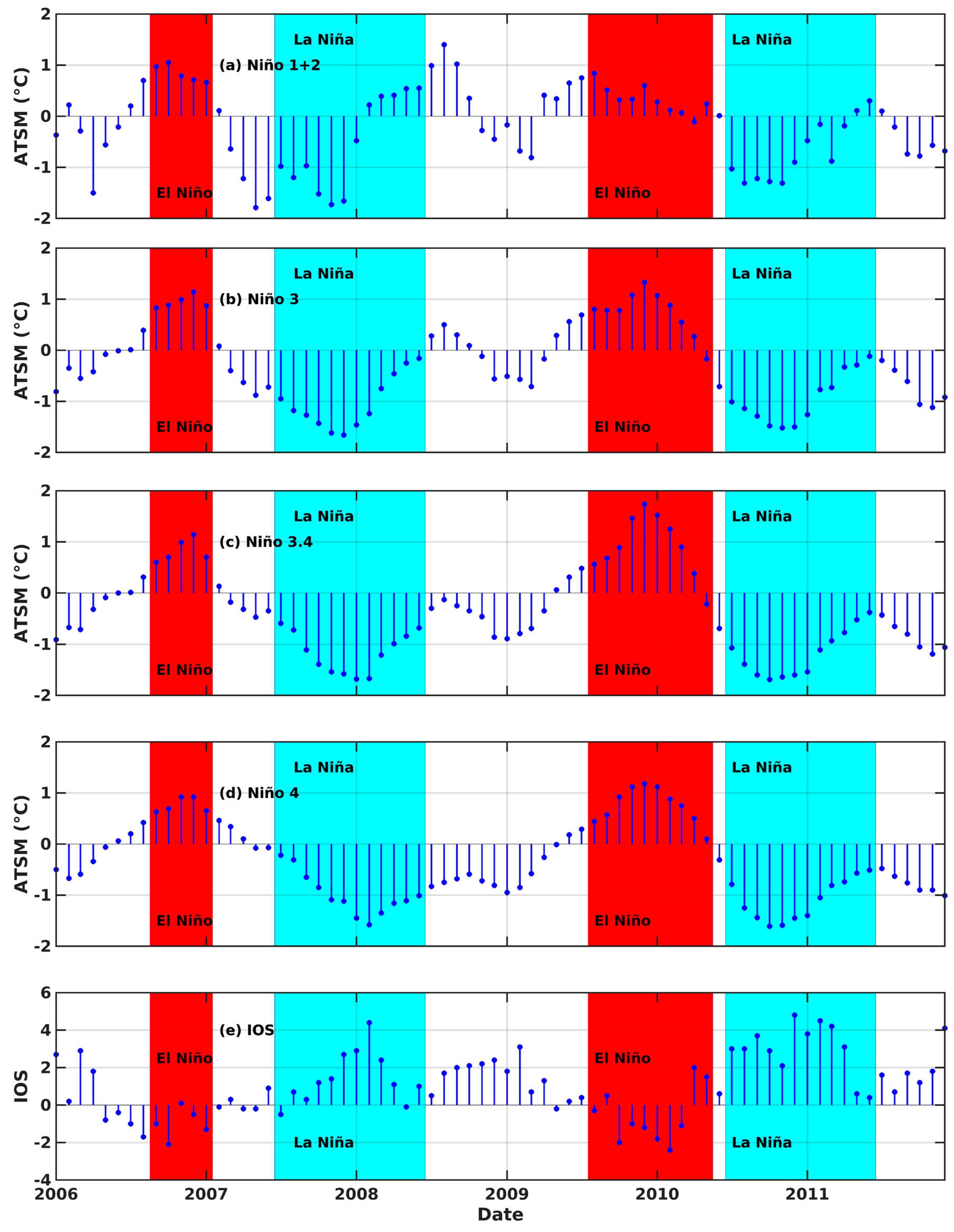
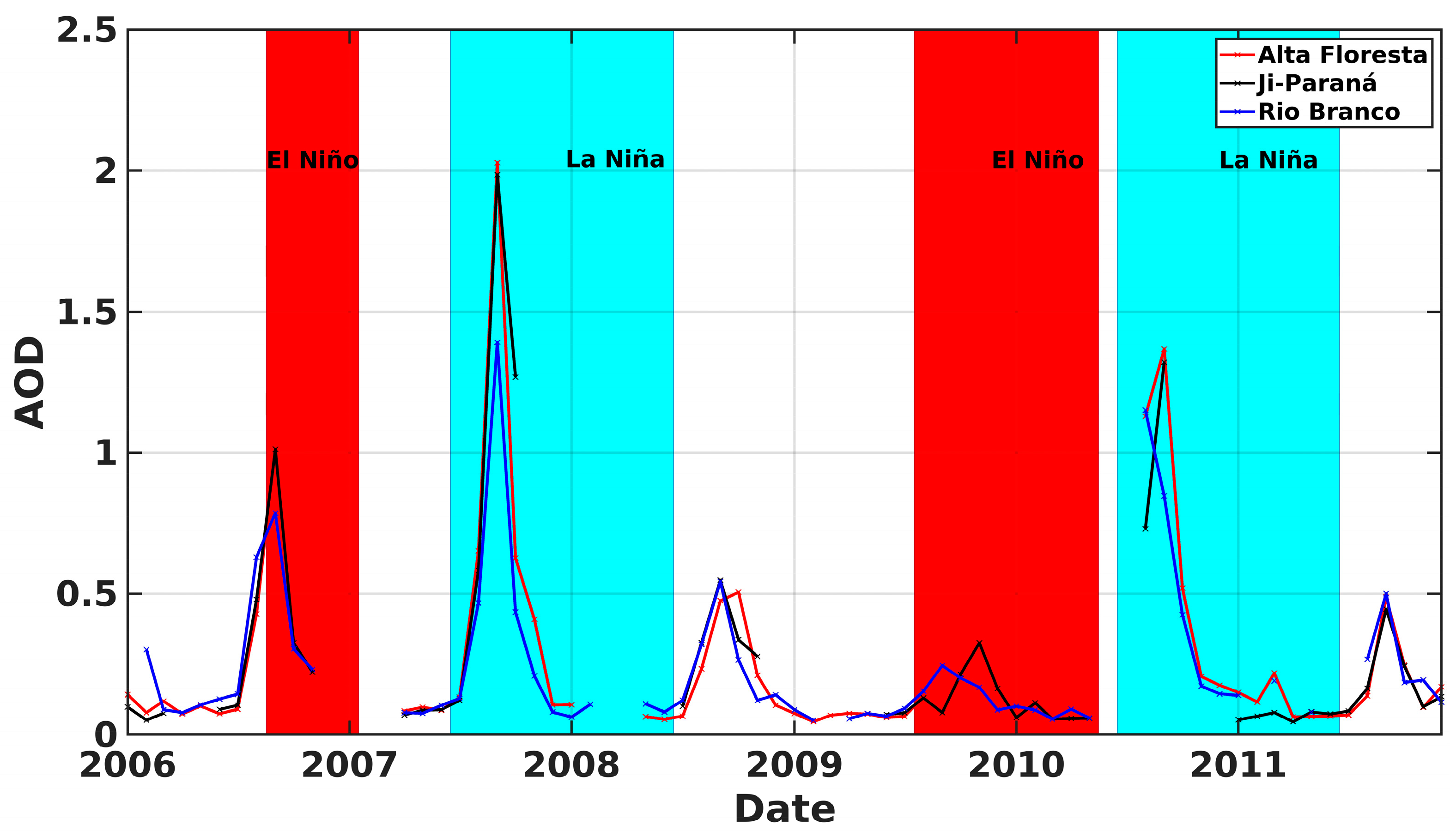


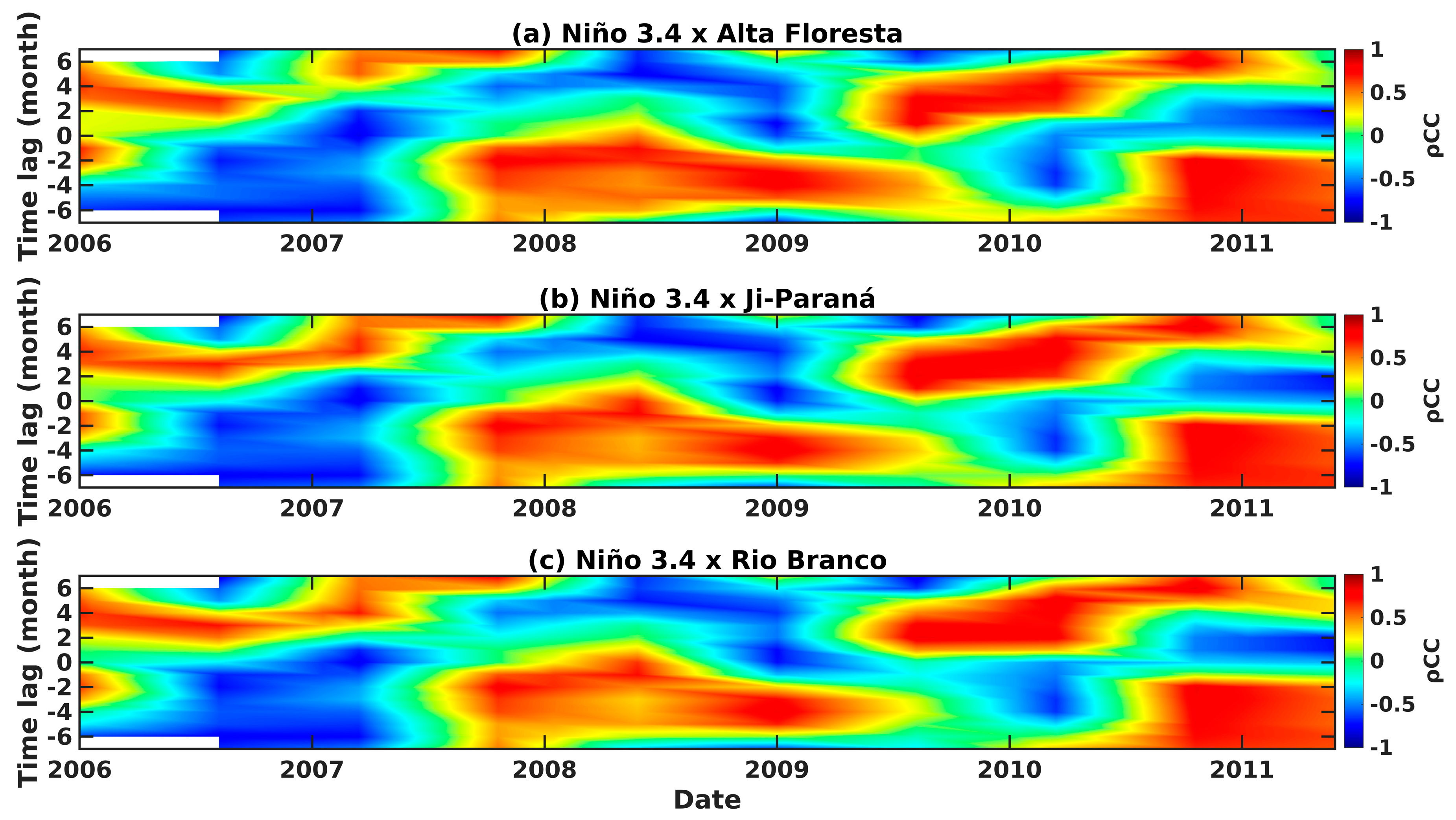
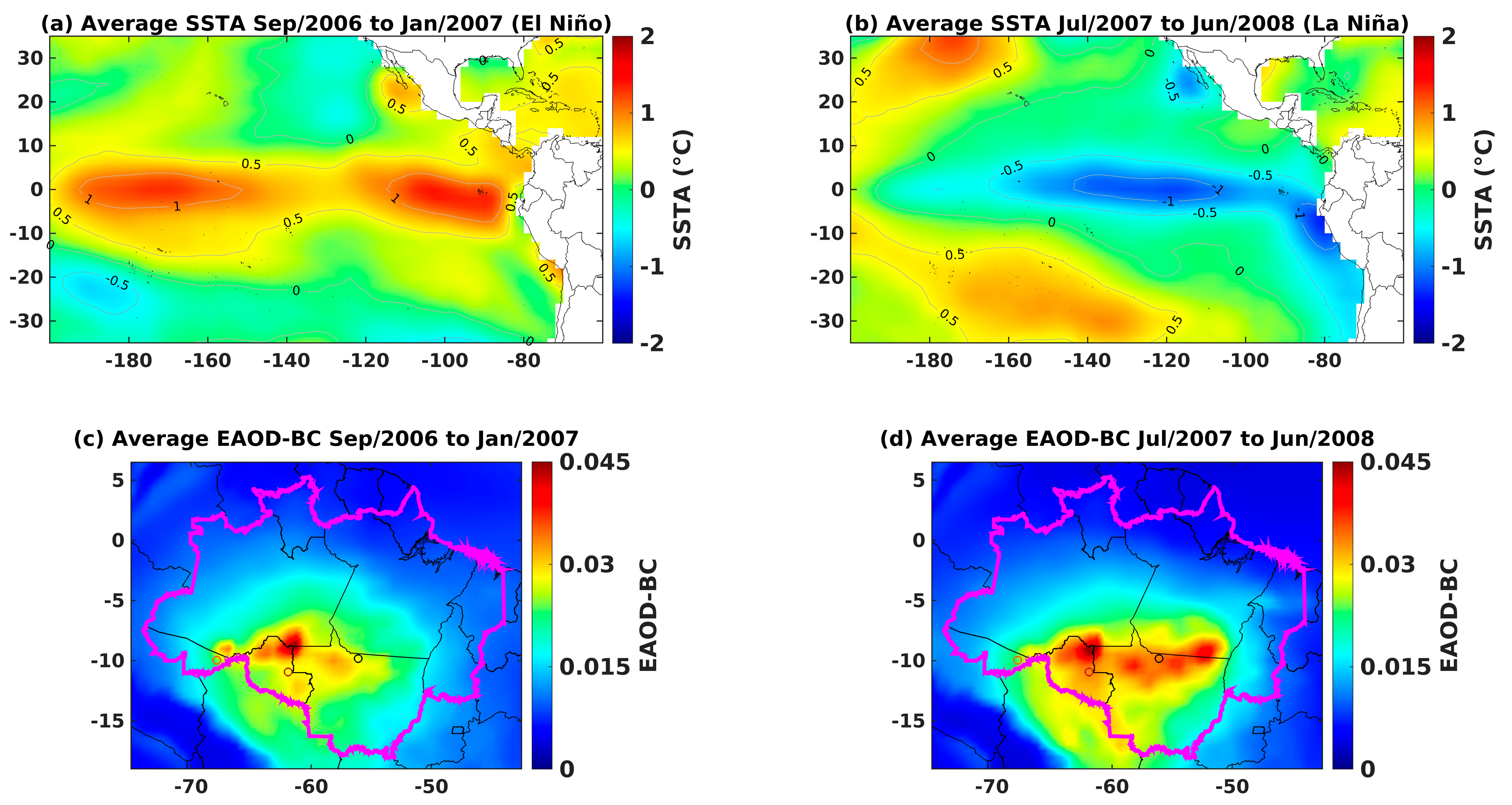


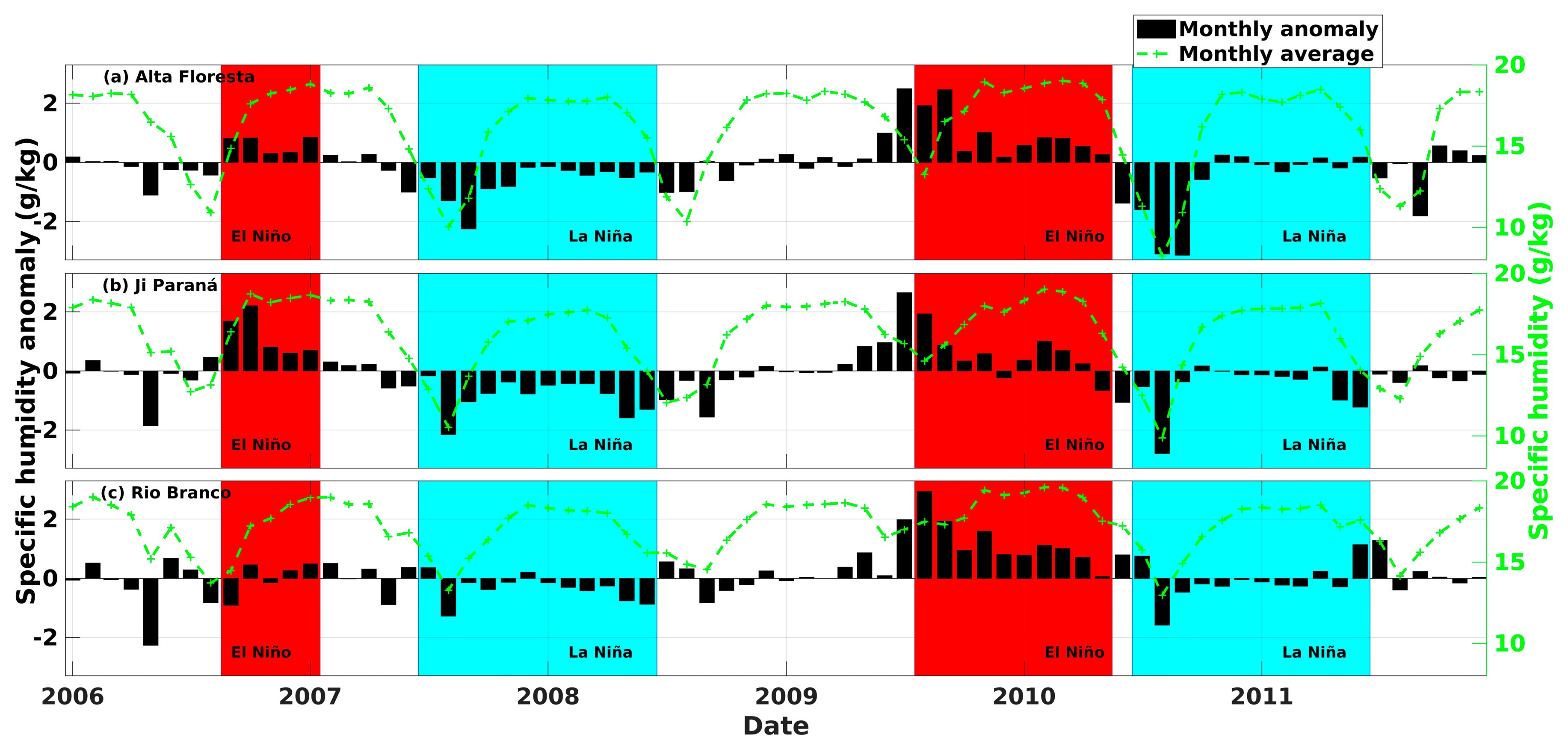
| Data | Spatial Resolution | Period | Source | Version | Data Scale |
|---|---|---|---|---|---|
| SSTA in Niño 1+2, Niño 3, Niño 3.4 and Niño 4 regions | 2° × 2° | Availability: 1950–present; Climatology: 1971–2000; Utilized in the Study: 2006–2011. | https://psl.noaa.gov/data/climateindices/list/ (accessed on 9 April 2023) | ERSSTV5 | Monthly |
| SOI | - | Availability: 1951–present; Utilized in the Study: 2006–2011. | https://psl.noaa.gov/data/climateindices/list/ (accessed on 9 April 2023) | - | Monthly |
| AOD500nm (AERONET) | - | Availability: 1993–2021 (AF), 2006–2021 (JP) e 2001–2023 (RB); Utilized in the Study: 2006–2011. | https://aeronet.gsfc.nasa.gov/ (accessed on 12 December 2022) | Nível 2.0 | Monthly |
| AOD550nm extinction for Black Carbon (MERRA2) | 0.5° × 0.625° | Availability: 1980–present; Utilized in the Study: 2006–2011 | https://disc.gsfc.nasa.gov/datasets?project=MERRA-2 (accessed on 27 July 2023) | M2TMNXAER v5.12.4 | Monthly |
| Specific Humidity Anomaly at 2 m (MERRA-2) | 0.5° × 0.625° | Availability: 1980–present; Climatology: 1980–2020; Utilized in the Study: 2006–2011 | https://disc.gsfc.nasa.gov/datasets?project=MERRA-2 (accessed on 20 June 2023) | M2TMNXSLV v5.12.4 | Monthly |
| Vertical Velocity Anomaly (Omega Anomaly, ωA) | 0.5° × 0.625° | Availability: 1980–present; Climatology: 1980–2020; Utilized in the Study: 2006–2011 | https://disc.gsfc.nasa.gov/datasets?project=MERRA-2 (accessed on 18 November 2023) | M2IMNPASM_5.12.4 | Monthly |
Disclaimer/Publisher’s Note: The statements, opinions and data contained in all publications are solely those of the individual author(s) and contributor(s) and not of MDPI and/or the editor(s). MDPI and/or the editor(s) disclaim responsibility for any injury to people or property resulting from any ideas, methods, instructions or products referred to in the content. |
© 2023 by the authors. Licensee MDPI, Basel, Switzerland. This article is an open access article distributed under the terms and conditions of the Creative Commons Attribution (CC BY) license (https://creativecommons.org/licenses/by/4.0/).
Share and Cite
Pereira, A.G.C.; Palácios, R.; Santos, P.C.R.; Pereira, R.V.S.; Cirino, G.; Imbiriba, B. Relationship between El Niño-Southern Oscillation and Atmospheric Aerosols in the Legal Amazon. Climate 2024, 12, 13. https://doi.org/10.3390/cli12020013
Pereira AGC, Palácios R, Santos PCR, Pereira RVS, Cirino G, Imbiriba B. Relationship between El Niño-Southern Oscillation and Atmospheric Aerosols in the Legal Amazon. Climate. 2024; 12(2):13. https://doi.org/10.3390/cli12020013
Chicago/Turabian StylePereira, Augusto G. C., Rafael Palácios, Paula C. R. Santos, Raimundo Vitor S. Pereira, Glauber Cirino, and Breno Imbiriba. 2024. "Relationship between El Niño-Southern Oscillation and Atmospheric Aerosols in the Legal Amazon" Climate 12, no. 2: 13. https://doi.org/10.3390/cli12020013
APA StylePereira, A. G. C., Palácios, R., Santos, P. C. R., Pereira, R. V. S., Cirino, G., & Imbiriba, B. (2024). Relationship between El Niño-Southern Oscillation and Atmospheric Aerosols in the Legal Amazon. Climate, 12(2), 13. https://doi.org/10.3390/cli12020013







